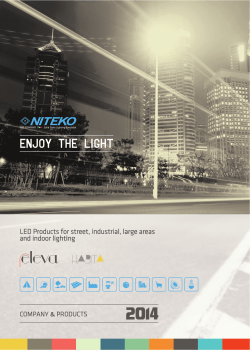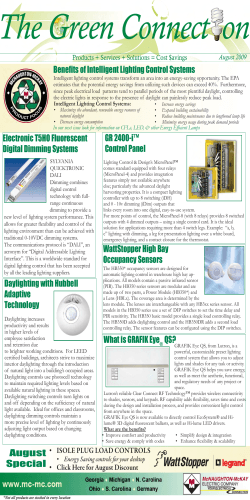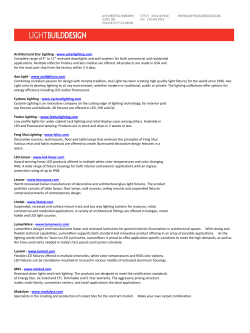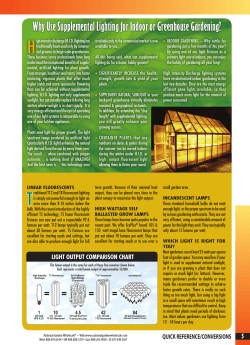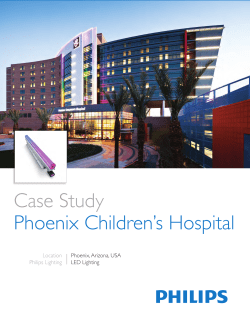
L How To LEED-Certified Lighting
cse0505howto.qxd 5/17/2005 12:41 PM Page 1 How To GAIN LEED POINTS VIA LIGHTING LEED-Certified Lighting Pays Off in Other Ways BY KEITH LANE, P.E., Lane Coburn & Associates, LLC. L EED certification can be difficult and expensive to obtain, and therefore requires creative input from all design entities. The electrical engineer can collaborate on several design levels to help the team obtain the intended certification level, particularly when it comes to energy savings from lighting systems. Lighting controls, as a minimum per local energy code compliance, is required on all LEED projects. In fact, it’s a prerequisite. In addition, lighting controls can be a major contributing factor to the Energy and Atmosphere category, Credit 1, Maximizing Energy Performance, and the Indoor Environmental Quality category, Credit 6, Controllability. The Minimum Energy Performance prerequisite is to meet the minimum level of energy efficiency as specified in ASHRAE/IESNA 90.1 or local energy codes, whichever is more stringent. The basic requirements include the use of occupancy sensors or lighting-control panels to turn lights off during hours of non-use. But another measure that can further improve the baseline energy performance is efficient controls technologies. These can include the use of dimming controls and dimming ballasts; photocells mounted in skylights; dual-technology earned in this category. Providing a quality lighting design that implements efficient T8 and T5 lamp technology, as well as the use of light-colored and reflective wall surfaces, can lead to more efficient lighting design. T5 high-output (HO) fluorescent fixtures can be utilized in parking garages in lieu of traditional metal-halide fixtures as a method to provide more energy-efficient lighting. Fluorescent fixtures provide for increased mean lumens per volt-ampere (LPVA) over traditional metal-halide fixtures. At 40% of fixture life, the T5-HO fluorescent fixture will provide 166% more LPVA. This could provide a tremendous savings over the life of a project, as well as garner LEED points that could be earned with this fixture (see chart below). Other T5-HO benefits include: 1. Longer lamp life—20,000 hours compared to 12,000 hours with metal-halides. 2. Superior and constant color over the life of the fixture. Metal-halide fixtures are notorious for color-shift problems. 3. A higher color-rendition index (82-85); metalhalide lamps have a CRI of 65-70. System Initial LUM VA Initial LPVA Mean LUM LLD Mean LPVA Base fixture: 175-watt metal-halide 14,400 222 65 9,300 0.65 42 8,800 119 74 8,272 0.94 70 T5 HO (2) occupancy sensors; and improved local controls, including those employing the digital addressable lighting interface (DALI) protocol. In addition, occupancy sensors can be integrated with the mechanical system and the building automation system to change heating and fan control when an area is not occupied. The combination of the use of sophisticated controls and lamp technology will optimize the points 4. Lower profiles. This can be an important criterion in parking garages with low ceiling clearance, especially in light of the high profile of many SUVs. 5. Less complex life-safety requirements. Because the time required to re-strike a metal-halide fixture far exceeds the required 10 seconds as specified in NEC 701, Life Safety Systems, a complicated system of quartz-restrike and time-delay relays is often required. C o n s u l t i n g - S p e c i f y i n g E n g i n e e r • M AY, 2 0 0 5 55 cse0505howto.qxd 5/17/2005 12:41 PM Page 2 How To The Indoor Environmental Quality category, Credit 6, Controllability of Systems, is intended to improve workers’ comfort conditions and productivity. Two credits can be achieved in this section. Advanced control The first credit, 6.1, requires an average of one lighting-control device for every 200 sq. ft. for all occupied areas within 15 ft. of a perimeter wall. This can be achieved by utilizing independent line-voltage or low-voltage switching or photocell/daylight controls. A higherend option is to utilize DALI technology. Such a system allows the potential for all occupants to independently control light levels in their work areas. Beyond personal comfort, DALI technology can also offer significant energy savings and unequaled control. Luminaires can be controlled separately or in large groups. Because the dimming ballasts have digital addresses, as spaces change, control areas can be reprogrammed. Dimming can be achieved locally or from a central location. Additionally, a central station can monitor energy-use profiles and identify lamp or ballast failure. DALI can also be utilized to verify energy savings. This capablity would contribute to the Energy and Atmosphere Credit 5, Measurement and Verification. This credit is intended to promote a design that provides for ongoing accountability and optimization of building-energy and water-consumption performance over time. The requirements to achieve this credit go above and beyond just measuring lighting energy and include: motor loads, variable-frequency Avoiding light trespass sometimes requires light levels lower than those recommended by IESNA. drives, chillers, cooling loads, air and water economizers, air distribution, boilers, building processes, indoor water risers and outdoor irrigation systems. Be aware, however, that DALI-generated lighting-energy verification would have to be integrated into the complete BAS. Be warned that DALI is also not a panacea. It has not been widely used to date, and there can be difficulties matching components into a cohesive system. Commissioning issues have also restricted its use. Other point possibilities Another indoor environmental quality credit, 6.2, can be achieved by providing one lighting control per occupant for half of the regularly occupied non-perimeter areas. The same design approach utilized for credit 6.1 also work here. Away from the LEED process itself, designing lighting systems to this stan- Energy-Optimization Performance Scoring Chart New Buildings 15% 20% 25% 30% 35% 40% 45% 50% 55% 60% 56 Existing Buildings 5% 10% . . . . . . . . . . . . . . . . . . . . . . . . . . . 15% . . . . . . . . . . . . . . . . . . . . . . . . . . . 20% . . . . . . . . . . . . . . . . . . . . . . . . . . . 25% . . . . . . . . . . . . . . . . . . . . . . . . . . . 30% . . . . . . . . . . . . . . . . . . . . . . . . . . . 35% . . . . . . . . . . . . . . . . . . . . . . . . . . . 40% . . . . . . . . . . . . . . . . . . . . . . . . . . . 45% . . . . . . . . . . . . . . . . . . . . . . . . . . . 50% ............................ ........................... Points 1 2 ............................3 ............................4 ............................5 ............................6 ............................7 ............................8 ............................9 . . . . . . . . . . . . . . . . . . . . . . . . . . . 10 ............................ ............................ C o n s u l t i n g - S p e c i f y i n g E n g i n e e r • M AY, 2 0 0 5 dard offers additional advantages, one of which is capitalizing on energy incentives sometimes offered by electric utilities. For example, power utilities in the Seattle area offer incentives for lighting systems based on the total kilowatt-hour savings accrued above the energy-code requirements. These savings are calculated over the first year that the building is occupied. LEED’s renewable energy credit requires that at least 5% of a building’s total energy consumption is through the use of on-site renewable energy systems. Technologies required to achieve this credit include solar, wind, geothermal, low-impact hydro, biomass and biogas. If the building gets 10% of its total energy requirements from renewable energy, an additional point is earned. At 20%, a third point is earned. Light pollution Finally, an area where electrical engineers can help in the LEED process is curtailing light pollution. The intent of LEED 2.1 Credit 8, Light Pollution Reduction, is to eliminate light trespass from the building and the site, improve night-sky access and reduce development impact on nocturnal environments. The designer must first provide lower light levels than those recommended by the IESNA (Illuminating Engineering Society of North America). When it comes to reducing light trespass, all exterior light fixtures with more than 1,000 lumens must be shielded, and all fixtures with more than 3,500 lumens must meet the full cutoff classification. Full cutoff will allow no lumens at or above the nadir and candela at less than 10% of rated lumens between 80 and 90 degrees. In addition, the maximum candela of all interior lighting must fall within the building. The intent is to keep light inside the building. The maximum candela value of all exterior lighting shall fall within the property. All pole lighting and lighting mounted on the building façade must also have shielding so that no light from the fixture crosses the property line. Computer modeling is required to prove that the design meets the requirements as stated above.
© Copyright 2026



